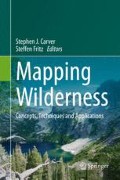Abstract
Wilderness is normally visualised using conventional mapping approaches showing the least touched spaces on the planet. Because most of the world’s population lives in very limited spaces, this is a useful method of representation. The effects of human action, however, go much further than that, resulting in much of the land area being relatively close to humankind while the remotest and ‘wildest’ spaces are very little areas on a normal map. This chapter looks at alternative ways to visualise the most remote parts of the land area: by deploying a so-called gridded cartogram transformation to data about the (in)accessibility of a place, the resulting cartograms reveal the areas and the extent of the remotest spaces in a much less common way. Gridded cartograms are created by using an equally distributed grid onto which a density-equalising cartogram technique is applied. Each individual grid cell is resized according to its the average travel time to the nearest larger city. This technique is not only applied to the global scale, but also to regional and national-level data. The results are maps that give the remotest places most space and provide a unique and highly visual perspective on the spatial dimension of remoteness.
Access this chapter
Tax calculation will be finalised at checkout
Purchases are for personal use only
References
CIESIN and CIAT (Center for International Earth Science Information Network/Centro Internacional de Agricultura Tropical, Socioeconomic Data and Applications Center (SEDAC), Columbia University, NY). (2005). Gridded Population of the World Version 3 (GPWv3): Population grids. http://sedac.ciesin.columbia.edu/gpw/global.jsp. Last accessed 1 May 2013.
Dorling, D. (2006). New maps of the world, its people, and their lives. Society of Cartographers Bulletin, 39(1–2), 35–40.
Gastner, M. T., & Newman, M. E. J. (2004). Diffusion-based method for producing density equalizing maps. Proceedings of the National Academy of Sciences of the United States of America, 101, 7499–7504. doi: arXiv:physics/0401102v1 [physics.data-an].
Hengl, T. (2011). Global datasets. http://spatial-analyst.net/wiki/index.php?title=Global_datasets. Last accessed 1 June 2011.
Hennig, B. D. (2013). Rediscovering the world: Map transformations of human and physical space. Berlin/Heidelberg: Springer. doi:10.1007/978-3-642-34848-8.
Hennig, B. D. (2014). Gridded cartograms as a method for visualising earthquake risk at the global scale. Journal of Maps, 10(2). doi:10.1080/17445647.2013.806229.
Hennig, B. D., Pritchard, J., Ramsden, M., & Dorling, D. (2010). Remapping the world’s population. Visualizing data using cartograms. ArcUser, 2010(1), 66–69.
Holmes, N. (Ed.). (2011). How to land a jumbo jet, a visual exploration of travel facts, figures and ephemera. Victoria: Lonely Planet.
Nelson, A. (2008). Travel time to major cities. Report. Luxembourg: European Commission.
NOAA (National Oceanic and Atmospheric Administration). (2009). ETOPO1 global relief model. http://www.ngdc.noaa.gov/mgg/global/global.html. Last accessed 1 May 2013.
Steffen, W., et al. (2011). The Anthropocene: From global change to planetary stewardship. AMBIO, 40(7), 739–761.
Uchida, H., & Nelson, A. (2010). Agglomeration index: Towards a new measure of urban concentration. In J. Beall, B. Guha-Khasnobis, & R. Kanbur (Eds.), Urbanization and development: Multidisciplinary perspectives (pp. 41–60). New York: Oxford University Press.
UNPD (United Nations Population Division). (2009). World urbanization prospects: The 2009 revision (Report). New York: United Nations Publications.
USGS (US Geological Survey). (2009). GTOPO30. http://eros.usgs.gov/#/Find_Data/Products_and_Data_Available/gtopo30_info. Last accessed 1 June 2011.
Author information
Authors and Affiliations
Corresponding author
Editor information
Editors and Affiliations
Rights and permissions
Copyright information
© 2016 Springer Science+Business Media Dordrecht
About this chapter
Cite this chapter
Hennig, B.D. (2016). Visualising Spaces of Global Inaccessibility. In: Carver, S., Fritz, S. (eds) Mapping Wilderness. Springer, Dordrecht. https://doi.org/10.1007/978-94-017-7399-7_7
Download citation
DOI: https://doi.org/10.1007/978-94-017-7399-7_7
Published:
Publisher Name: Springer, Dordrecht
Print ISBN: 978-94-017-7397-3
Online ISBN: 978-94-017-7399-7
eBook Packages: Earth and Environmental ScienceEarth and Environmental Science (R0)

